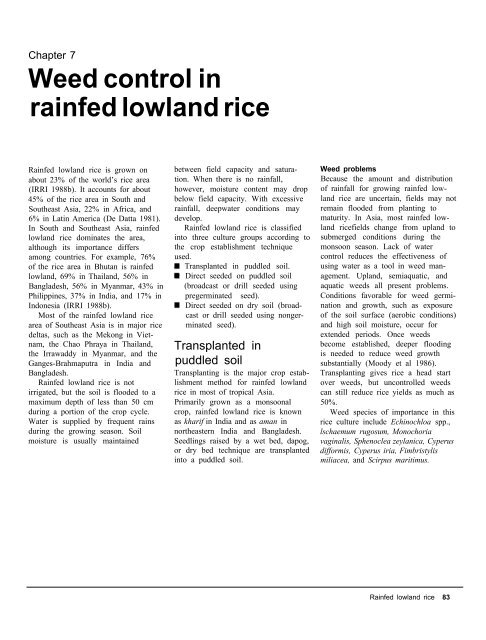A handbbok on Weed Control in Rice.pdf
A handbbok on Weed Control in Rice.pdf
A handbbok on Weed Control in Rice.pdf
You also want an ePaper? Increase the reach of your titles
YUMPU automatically turns print PDFs into web optimized ePapers that Google loves.
Chapter 7<br />
<strong>Weed</strong> c<strong>on</strong>trol <strong>in</strong><br />
ra<strong>in</strong>fed lowland rice<br />
Ra<strong>in</strong>fed lowland rice is grown <strong>on</strong><br />
about 23% of the world’s rice area<br />
(IRRI 1988b). It accounts for about<br />
45% of the rice area <strong>in</strong> South and<br />
Southeast Asia, 22% <strong>in</strong> Africa, and<br />
6% <strong>in</strong> Lat<strong>in</strong> America (De Datta 1981).<br />
In South and Southeast Asia, ra<strong>in</strong>fed<br />
lowland rice dom<strong>in</strong>ates the area,<br />
although its importance differs<br />
am<strong>on</strong>g countries. For example, 76%<br />
of the rice area <strong>in</strong> Bhutan is ra<strong>in</strong>fed<br />
lowland, 69% <strong>in</strong> Thailand, 56% <strong>in</strong><br />
Bangladesh, 56% <strong>in</strong> Myanmar, 43% <strong>in</strong><br />
Philipp<strong>in</strong>es, 37% <strong>in</strong> India, and 17% <strong>in</strong><br />
Ind<strong>on</strong>esia (IRRI 1988b).<br />
Most of the ra<strong>in</strong>fed lowland rice<br />
area of Southeast Asia is <strong>in</strong> major rice<br />
deltas, such as the Mek<strong>on</strong>g <strong>in</strong> Vietnam,<br />
the Chao Phraya <strong>in</strong> Thailand,<br />
the Irrawaddy <strong>in</strong> Myanmar, and the<br />
Ganges-Brahmaputra <strong>in</strong> India and<br />
Bangladesh.<br />
Ra<strong>in</strong>fed lowland rice is not<br />
irrigated, but the soil is flooded to a<br />
maximum depth of less than 50 cm<br />
dur<strong>in</strong>g a porti<strong>on</strong> of the crop cycle.<br />
Water is supplied by frequent ra<strong>in</strong>s<br />
dur<strong>in</strong>g the grow<strong>in</strong>g seas<strong>on</strong>. Soil<br />
moisture is usually ma<strong>in</strong>ta<strong>in</strong>ed<br />
between field capacity and satura-<br />
ti<strong>on</strong>. When there is no ra<strong>in</strong>fall,<br />
however, moisture c<strong>on</strong>tent may drop<br />
below field capacity. With excessive<br />
ra<strong>in</strong>fall, deepwater c<strong>on</strong>diti<strong>on</strong>s may<br />
develop.<br />
Ra<strong>in</strong>fed lowland rice is classified<br />
<strong>in</strong>to three culture groups accord<strong>in</strong>g to<br />
the crop establishment technique<br />
used.<br />
Transplanted <strong>in</strong> puddled soil.<br />
Direct seeded <strong>on</strong> puddled soil<br />
(broadcast or drill seeded us<strong>in</strong>g<br />
pregerm<strong>in</strong>ated seed).<br />
Direct seeded <strong>on</strong> dry soil (broad-<br />
cast or drill seeded us<strong>in</strong>g n<strong>on</strong>ger-<br />
m<strong>in</strong>ated seed).<br />
Transplanted <strong>in</strong><br />
puddled soil<br />
Transplant<strong>in</strong>g is the major crop estab-<br />
lishment method for ra<strong>in</strong>fed lowland<br />
rice <strong>in</strong> most of tropical Asia.<br />
Primarily grown as a m<strong>on</strong>so<strong>on</strong>al<br />
crop, ra<strong>in</strong>fed lowland rice is known<br />
as kharif <strong>in</strong> India and as aman <strong>in</strong><br />
northeastern India and Bangladesh.<br />
Seedl<strong>in</strong>gs raised by a wet bed, dapog,<br />
or dry bed technique are transplanted<br />
<strong>in</strong>to a puddled soil.<br />
<strong>Weed</strong> problems<br />
Because the amount and distributi<strong>on</strong><br />
of ra<strong>in</strong>fall for grow<strong>in</strong>g ra<strong>in</strong>fed low-<br />
land rice are uncerta<strong>in</strong>, fields may not<br />
rema<strong>in</strong> flooded from plant<strong>in</strong>g to<br />
maturity. In Asia, most ra<strong>in</strong>fed low-<br />
land ricefields change from upland to<br />
submerged c<strong>on</strong>diti<strong>on</strong>s dur<strong>in</strong>g the<br />
m<strong>on</strong>so<strong>on</strong> seas<strong>on</strong>. Lack of water<br />
c<strong>on</strong>trol reduces the effectiveness of<br />
us<strong>in</strong>g water as a tool <strong>in</strong> weed man-<br />
agement. Upland, semiaquatic, and<br />
aquatic weeds all present problems.<br />
C<strong>on</strong>diti<strong>on</strong>s favorable for weed germi-<br />
nati<strong>on</strong> and growth, such as exposure<br />
of the soil surface (aerobic c<strong>on</strong>diti<strong>on</strong>s)<br />
and high soil moisture, occur for<br />
extended periods. Once weeds<br />
become established, deeper flood<strong>in</strong>g<br />
is needed to reduce weed growth<br />
substantially (Moody et al 1986).<br />
Transplant<strong>in</strong>g gives rice a head start<br />
over weeds, but unc<strong>on</strong>trolled weeds<br />
can still reduce rice yields as much as<br />
50%.<br />
<strong>Weed</strong> species of importance <strong>in</strong> this<br />
rice culture <strong>in</strong>clude Ech<strong>in</strong>ochloa spp.,<br />
lschaemum rugosum, M<strong>on</strong>ochoria<br />
vag<strong>in</strong>alis, Sphenoclea zeylanica, Cyperus<br />
difformis, Cyperus iria, Fimbristylis<br />
miliacea, and Scirpus maritimus.<br />
Ra<strong>in</strong>fed lowland rice 83











